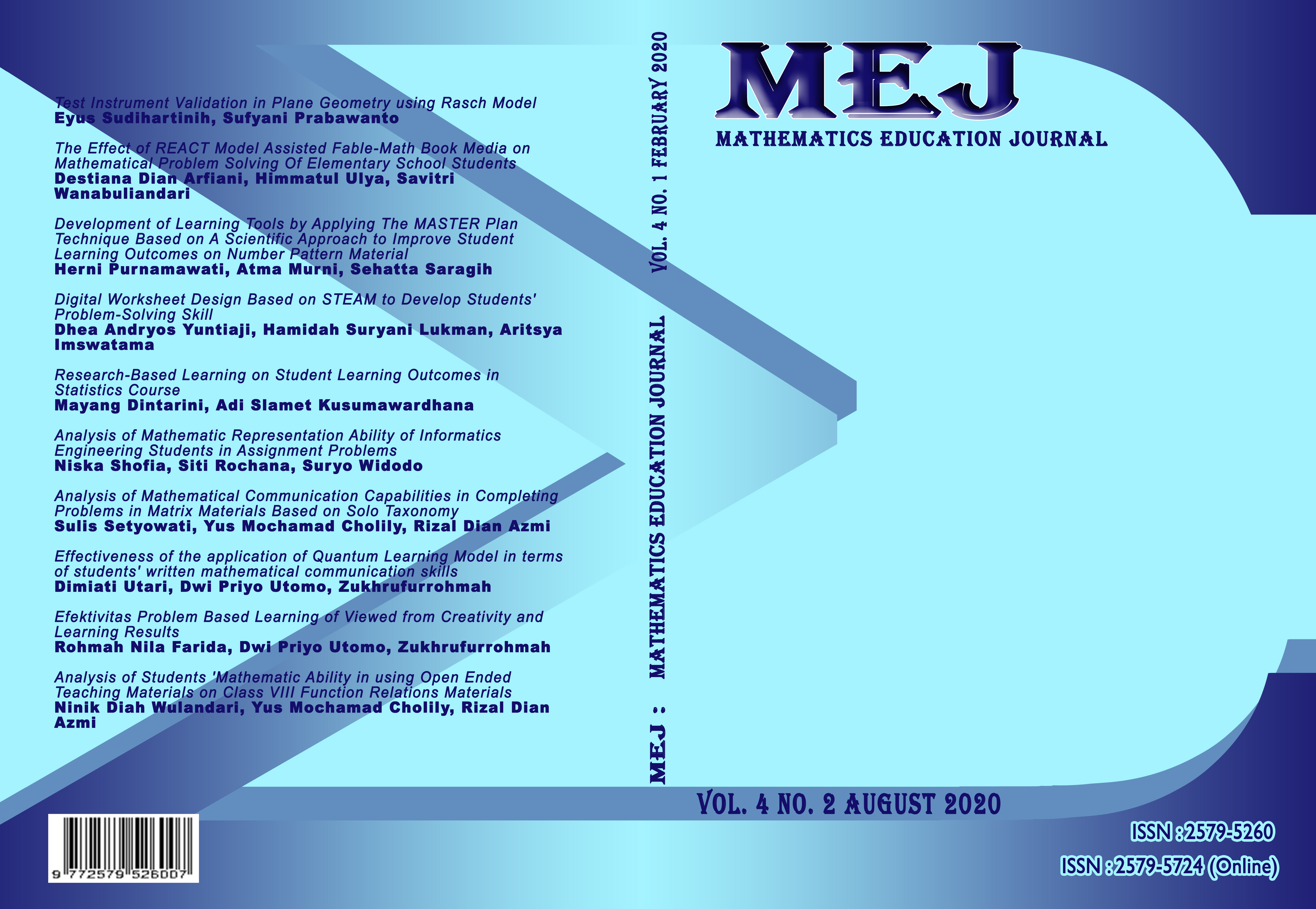Analysis of Mathematic Representation Ability of Informatics Engineering Students in Assignment Problems
DOI:
https://doi.org/10.22219/mej.v4i2.12419Keywords:
mathematical representation, multiple representations, assignment problems, operations researchAbstract
Mathematics is a field of science that can improve a person's ability to think logically, critically, rationalistically, effectively, carefully and efficiently. To find out a person's ability to think logically, critically, rationalistically, effectively, carefully and efficiently in solving mathematical problems, an analysis of mathematical representations is needed. Mathematical representation is needed in solving Operations Research problems, because operations research uses a mathematical model as a problem-solving approach. This research discusses the mathematical representation ability of informatics engineering students at Nusantara University PGRI Kediri in solving assignment problems in Operations Research courses. The research method used includes descriptive research with a qualitative research approach. Data were taken directly from the research location using interviews and tests on 3 research subjects, namely students with high, medium and low abilities. The subject selection is based on the results of the dialogue between the researcher and the student's mathematics subject lecturer. Based on the results of research, high-ability students can complete multiple representations both visually, symbolically and verbally. Likewise for the mathematical representation of moderate-capable students is having multiple representations, but there are steps in solving that are missed in verbal representations. Low-ability students only provide visual and verbal representations, while symbolic representations still have errors. However, all three are still lacking in terms of the implementation of the final results
Downloads
References
Aminudin (2005). Prinsip-Prinsip Riset Operasi. Jakarta: Erlangga
Basir, M. A., & Maharani, H. R (2016). Reasoning Ability Students in Mathematics Problems Solving Viewed from Cognitive Style. Prosiding In The 2nd International Seminar On Educational Technology May 2016 p. 99-102
Gagatsis, Anthanasios and Iliada Elia (2004). The Effects Of Different Modes Of Representation On Mathematical Problem Solving. Proceeding of the 28th Conference of the International Group for the Psychology of Mathematics Education. Vol 22 pp 447-454.
Goldin, G.A., Kaput, J.J (2015). A Joint Perspective on The Idea of Representation in Learning and Doing Mathematics. ResearchGate. Diakses oktober 2019 dari https://www.researchgate.net/publication/269407907
Hayatunnizar (2017). Meningkatkan Kemampuan Representasi Matematis Melalui Penerapan Model Problem Base Learning. Jurnal Didaktik Matematika. 4 (1), 119-128.
Irawati Sri, dan Sri Indriati Hasanah (2016). Representasi Mahasiswa Berkemampan Matematika Tinggi Dalam Memecahkan Masalah Program Linier. Jurnal Inovasi Volume 18, Nomor 1 Januari 2016.
Izati, Dwi dkk (2017). Analisis Peningkatan Representasi Matematis Siswa SMA Ditinjau dari Perbedaan Gender. Jurnal Didaktik Matematika Vol. 4 No. 2 September 2017.
Junita, Ranisa (2016). Kemampuan Representasi dan Komunikasi Matematis Peserta Didik SMA Ditinjau dari Prestasi Belajar dan Gaya Kognitif. Pythagoras: Jurnal Pendidikan Matematika Volume 11 – Nomor 2, Desember 2016, (193-206).
Kartini (2009). Peranan Representasi Dalam Pembelajaran Matematika. Prosiding Seminar Matematika dan Pendidikan Matematika FMIPA UNY 05 Desember 2009.
Krawec, Jenifer Lee (2010). Problem Representation and Mathematical Problem Solving of Students of Variying Math Ability. Electrovnic Theses and Disertation. http://scholarlyrepository.miami.edu/cgi/viewcontent.cgi?article=1454&context=oa_dissertations
NCTM (2000). Principles and Standards for School Mathematics. Reston VA: NCTM.
Sabirin, Muhamad (2014). Representasi Dalam Pembelajaran Matematika. JPM IAIN Antasari,Vol. 01 No. 2, 33-34.
Sanjaya, Indrayana Ika, dkk (2018). Kemampuan Representasi Siswa Pada Materi Lingkaran Berdasar Gaya Belajar Honey Mumford. Kontinu: Jurnal Penelitian Didaktik Matematika Vol 2 No. 2, Oktober 2018.
Shofia, Niska (2019). Analisis Representasi Matematis Mahasiswa Teknik Informatika Dalam Menyelesaikan Soal Riset Operasi, Jurnal Efektor, Volume 6 Issue 2, 136-141
Siang, Jong Jek (2011). Riset Operasi Dalam Pendekatan Algoritmis. Yogyakarta: Andi
Sugiyono (2007). Metode Penelitian Pendidikan: Pendekatan Kuantitatif, Kualitatif dan R&D. Bandung: Alfabeta.
Ulandari, A. R. P., Hudiono, B., & Bistari (2015). Kemampuan representasi matematis menyelesaikan soal open-ended menurut tingkat kemampuan dasar materi segiempat di smp. Jurnal Pendidikan dan Pembelajaran Khatulistiwa, Vol 4, No 6, h.1–10.
Wu-Yin Hwang, et all (2007). Multiple Representation Skills and Creativity Effects on Mathematical Problem Solving Using A Multimedia Whiteboard System. Educational Technology & Society. 10 (2), 191-212
Downloads
Published
Issue
Section
License
Authors who publish with MEJ (Mathematics Education Journal) agree to the following terms:
For all articles published in MEJ, copyright is retained by the authors. Authors give permission to the publisher to announce the work with conditions. When the manuscript is accepted for publication, the authors agree to automatic transfer of the publishing right to the publisher.
Authors retain copyright and grant the journal right of first publication with the work simultaneously licensed under a Creative Commons Attribution-ShareAlike 4.0 International License that allows others to share the work with an acknowledgment of the work's authorship and initial publication in this journal.
Authors are able to enter into separate, additional contractual arrangements for the non-exclusive distribution of the journal's published version of the work (e.g., post it to an institutional repository or publish it in a book), with an acknowledgment of its initial publication in this journal.
Authors are permitted and encouraged to post their work online (e.g., in institutional repositories or on their website) prior to and during the submission process, as it can lead to productive exchanges, as well as earlier and greater citation of published work (See The Effect of Open Access).

This work is licensed under a Creative Commons Attribution-ShareAlike 4.0 International License.










